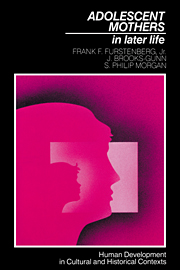Book contents
- Frontmatter
- Contents
- List of tables and figures
- Preface
- 1 Reassessing adolescent parenthood
- 2 Experience in adulthood
- 3 Pathways to success in adulthood
- 4 The children's experience
- 5 The intersecting life courses of adolescent mothers and their children
- 6 The life course of adolescent mothers: implications for public policy
- Appendixes
- Bibliography
- Index
2 - Experience in adulthood
Published online by Cambridge University Press: 04 August 2010
- Frontmatter
- Contents
- List of tables and figures
- Preface
- 1 Reassessing adolescent parenthood
- 2 Experience in adulthood
- 3 Pathways to success in adulthood
- 4 The children's experience
- 5 The intersecting life courses of adolescent mothers and their children
- 6 The life course of adolescent mothers: implications for public policy
- Appendixes
- Bibliography
- Index
Summary
Looking back on the transition to parenthood
Nearly all participants in the Baltimore study were in their middle teens when they first became pregnant and in their early twenties at the 5-year follow-up. This chapter reviews their life histories in the subsequent period from 1972 to 1984. We have omitted a full description of the teenage years, when most of the young mothers were struggling to remain in school, enter the job market, and establish a marital relationship while raising a child. These experiences are recorded in an earlier account of the study (Furstenberg, 1976). Because the next chapter will show how the early adjustment to parenthood significantly shapes the course of later life, however, it is useful to begin with a few observations about the transition to parenthood, even at the risk of covering familiar ground.
As we have said, it was not an easy time for the women in the study. Looking back on that period, many, recalling the problems that beset them after their first child was born, said they did not understand how they were able to get through those difficult years.
There is no “typical” transition to motherhood. The modal pattern, as will become more apparent later in this chapter, was unpredictable and disorderly, to borrow terms sometimes used to characterize the occupational careers of lowerstatus workers (Wilensky, 1961). Many women resumed their education only to drop out when marriage, child-care arrangements, or another pregnancy interfered with their school routines.
- Type
- Chapter
- Information
- Adolescent Mothers in Later Life , pp. 21 - 47Publisher: Cambridge University PressPrint publication year: 1987



